The FAA has lifted the grounding order on the Boeing 737 Max that was imposed in March 2019 after the aircraft crashed twice, enabling it to return to commercial service.
The FAA, safety regulators from around the world and Boeing have conducted an investigation and safety review into the crashes of Lion Air Flight 610 and Ethiopian Airlines Flight 302, which resulted in the tragic loss of 346 lives.
The investigations identified problems with the 737 Max’s manoeuvring characteristics augmentation system (MCAS) as the main cause of the crashes. The MCAS, which was added to the 737 because of the heavier engines used in the Max version, automatically compensates when it senses the aircraft is stalling by turning the nose of the plane down and incorrectly operated when the crashes occurred.
In addition to rescinding the order that grounded the aircraft, the FAA today published an Airworthiness Directive specifying design changes that must be made before the aircraft returns to service, issued a Continued Airworthiness Notification to the International Community (CANIC) and published the MAX training requirements.
Before the 737 Max can return to service the FAA must still approve revisions to the pilot training program for US airlines that operate the aircraft. The regulator will also still issue airworthiness certificates and export certificates of airworthiness for all of the 737 Max aircraft manufactured since the grounding order was issued.
The Airworthiness Directive describes a number of actions airlines must take before the 737 Max. These include the installing of software enhancements, completing wire separation modifications, conducting pilot training.
Airlines must also take a number of maintenance steps to prepare 737 Maxs that have been in storage for flight.
FAA Administrator Steve Dickson said, “In the coming weeks and months the FAA will continue to engage with domestic and international stakeholders as everyone takes the steps required to return the aircraft to service. Safety is our top priority – the travelling public expects and deserves no less.”
Boeing has made a number of organizational changes following the 737 Max crashes, including the creation of a new Products & Services safety unit as part of an effort to “unify safety responsibilities” across the company, a review of safety culture within the company and improvements to the design process to improve quality and safety.
David Calhoun, CEO of the Boeing Company said,”We will never forget the lives lost in the two tragic accidents that led to the decision to suspend operations. These events and the lessons we have learned as a result have reshaped our company and further focused our attention on our core values of safety, quality and integrity.”





